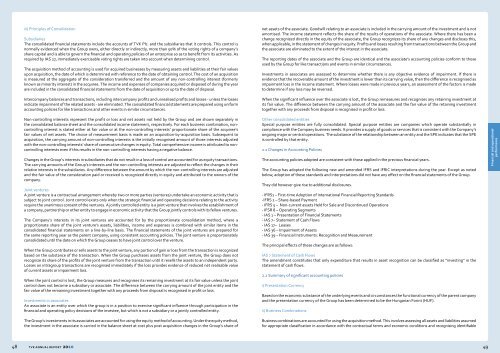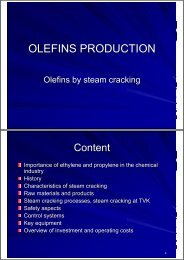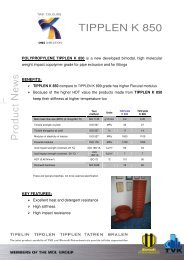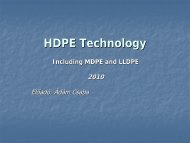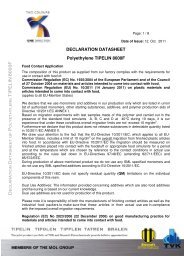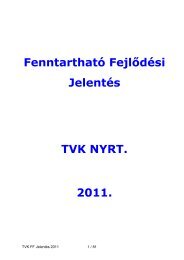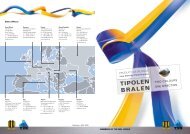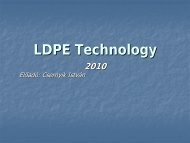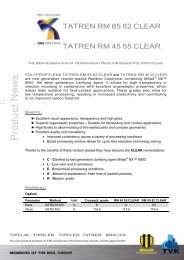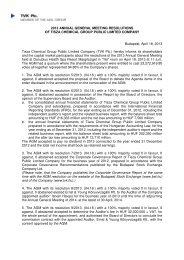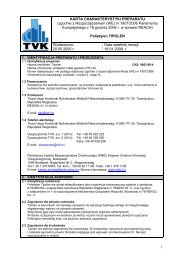TVK Annual Report 2010 (pdf, 2.5 MB)
TVK Annual Report 2010 (pdf, 2.5 MB)
TVK Annual Report 2010 (pdf, 2.5 MB)
You also want an ePaper? Increase the reach of your titles
YUMPU automatically turns print PDFs into web optimized ePapers that Google loves.
iii) Principles of Consolidation<br />
Subsidiaries<br />
The consolidated financial statements include the accounts of <strong>TVK</strong> Plc. and the subsidiaries that it controls. This control is<br />
normally evidenced when the Group owns, either directly or indirectly, more than 50% of the voting rights of a company’s<br />
share capital and is able to govern the financial and operating policies of an enterprise so as to benefit from its activities. As<br />
required by IAS 27, immediately exercisable voting rights are taken into account when determining control.<br />
The acquisition method of accounting is used for acquired businesses by measuring assets and liabilities at their fair values<br />
upon acquisition, the date of which is determined with reference to the date of obtaining control. The cost of an acquisition<br />
is measured at the aggregate of the consideration transferred and the amount of any non-controlling interest (formerly<br />
known as minority interest) in the acquiree. The income and expenses of companies acquired or disposed of during the year<br />
are included in the consolidated financial statements from the date of acquisition or up to the date of disposal.<br />
Intercompany balances and transactions, including intercompany profits and unrealised profits and losses - unless the losses<br />
indicate impairment of the related assets - are eliminated. The consolidated financial statements are prepared using uniform<br />
accounting policies for like transactions and other events in similar circumstances.<br />
net assets of the associate. Goodwill relating to an associate is included in the carrying amount of the investment and is not<br />
amortised. The income statement reflects the share of the results of operations of the associate. Where there has been a<br />
change recognized directly in the equity of the associate, the Group recognizes its share of any changes and discloses this,<br />
when applicable, in the statement of changes in equity. Profits and losses resulting from transactions between the Group and<br />
the associate are eliminated to the extent of the interest in the associate.<br />
The reporting dates of the associate and the Group are identical and the associate’s accounting policies conform to those<br />
used by the Group for like transactions and events in similar circumstances.<br />
Investments in associates are assessed to determine whether there is any objective evidence of impairment. If there is<br />
evidence that the recoverable amount of the investment is lower than its carrying value, then the difference is recognised as<br />
impairment loss in the income statement. Where losses were made in previous years, an assessment of the factors is made<br />
to determine if any loss may be reversed.<br />
When the significant influence over the associate is lost, the Group remeasures and recognises any retaining investment at<br />
its fair value. The difference between the carrying amount of the associate and the fair value of the retaining investment<br />
together with any proceeds from disposal is recognised in profit or loss.<br />
Non-controlling interests represent the profit or loss and net assets not held by the Group and are shown separately in<br />
the consolidated balance sheet and the consolidated income statement, respectively. For each business combination, noncontrolling<br />
interest is stated either at fair value or at the non-controlling interests’ proportionate share of the acquiree’s<br />
fair values of net assets. The choice of measurement basis is made on an acquisition-by-acquisition basis. Subsequent to<br />
acquisition, the carrying amount of non-controlling interests is the initially recognised amount of those interests adjusted<br />
with the non-controlling interests’ share of consecutive changes in equity. Total comprehensive income is attributed to noncontrolling<br />
interests even if this results in the non-controlling interests having a negative balance.<br />
Changes in the Group’s interests in subsidiaries that do not result in a loss of control are accounted for as equity transactions.<br />
The carrying amounts of the Group’s interests and the non-controlling interests are adjusted to reflect the changes in their<br />
relative interests in the subsidiaries. Any difference between the amount by which the non-controlling interests are adjusted<br />
and the fair value of the consideration paid or received is recognized directly in equity and attributed to the owners of the<br />
company.<br />
Joint ventures<br />
A joint venture is a contractual arrangement whereby two or more parties (ventures) undertake an economic activity that is<br />
subject to joint control. Joint control exists only when the strategic financial and operating decisions relating to the activity<br />
require the unanimous consent of the ventures. A jointly controlled entity is a joint venture that involves the establishment of<br />
a company, partnership or other entity to engage in economic activity that the Group jointly controls with its fellow ventures.<br />
The Company’s interests in its joint ventures are accounted for by the proportionate consolidation method, where a<br />
proportionate share of the joint venture’s assets, liabilities, income and expenses is combined with similar items in the<br />
consolidated financial statements on a line-by-line basis. The financial statements of the joint ventures are prepared for<br />
the same reporting year as the parent company, using consistent accounting policies. The joint venture is proportionately<br />
consolidated until the date on which the Group ceases to have joint control over the venture.<br />
When the Group contributes or sells assets to the joint venture, any portion of gain or loss from the transaction is recognized<br />
based on the substance of the transaction. When the Group purchases assets from the joint venture, the Group does not<br />
recognize its share of the profits of the joint venture from the transaction until it resells the assets to an independent party.<br />
Losses on intragroup transactions are recognised immediately if the loss provides evidence of reduced net realisable value<br />
of current assets or impairment loss.<br />
When the joint control is lost, the Group measures and recognises its remaining investment at its fair value unless the joint<br />
control does not become a subsidiary or associate. The difference between the carrying amount of the joint entity and the<br />
fair value of the remaining investment together with any proceeds from disposal is recognised in profit or loss.<br />
Investments in associates<br />
An associate is an entity over which the group is in a position to exercise significant influence through participation in the<br />
financial and operating policy decisions of the investee, but which is not a subsidiary or a jointly controlled entity.<br />
Other consolidated entities<br />
Special purpose entities are fully consolidated. Special purpose entities are companies which operate substantially in<br />
compliance with the Company business needs. It provides a supply of goods or services that is consistent with the Company’s<br />
ongoing major or central operations. The substance of the relationship between an entity and the SPE indicates that the SPE<br />
is controlled by that entity.<br />
2.1 Changes in Accounting Policies<br />
The accounting policies adopted are consistent with those applied in the previous financial years.<br />
The Group has adopted the following new and amended IFRS and IFRIC interpretations during the year. Except as noted<br />
below, adoption of these standards and interpretations did not have any effect on the financial statements of the Group.<br />
They did however give rise to additional disclosures.<br />
- IFRS1 – First-time Adoption of International Financial <strong>Report</strong>ing Standards<br />
-IFRS 2 – Share-based Payment<br />
- IFRS 5 – Non-current assets Held for Sale and Discontinued Operations<br />
- IFSR 8 – Operating Segments<br />
- IAS 1 – Presentation of Financial Statements<br />
- IAS 7– Statement of Cash Flows<br />
- IAS 17– Leases<br />
- IAS 36 – Impairment of Assets<br />
- IAS 39 – Financial Instruments: Recognition and Measurement<br />
The principal effects of these changes are as follows:<br />
IAS 7 Statement of Cash Flows<br />
The amendment constitutes that only expenditure that results in asset recognition can be classified as “investing” in the<br />
statement of cash flows.<br />
2.2 Summary of significant accounting policies<br />
i) Presentation Currency<br />
Based on the economic substance of the underlying events and circumstances the functional currency of the parent company<br />
and the presentation currency of the Group has been determined to be the Hungarian Forint (HUF).<br />
ii) Business Combinations<br />
Financial and operational<br />
performance<br />
The Group’s investments in its associates are accounted for using the equity method of accounting. Under the equity method,<br />
the investment in the associate is carried in the balance sheet at cost plus post acquisition changes in the Group’s share of<br />
Business combinations are accounted for using the acquisition method. This involves assessing all assets and liabilities assumed<br />
for appropriate classification in accordance with the contractual terms and economic conditions and recognising identifiable<br />
48 <strong>TVK</strong> <strong>Annual</strong> <strong>Report</strong> <strong>2010</strong><br />
49


